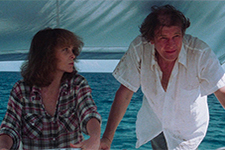Zombie (Zombi 2) (4K UHD)
|  When I first saw Lucio Fulci’s Zombie more than 20 years ago, I absolutely hated it. I had just recently seen George A. Romero’s zombie trilogy (1968’s Night of the Living Dead, 1978’s Dawn of the Dead, and 1985’s Day of the Dead), and I couldn’t get past the fact that Fulci’s film seemed like such an unapologetic rip-off. Part of this was simply perception due to the film’s original Italian title Zombi 2, a shameless marketing ploy to associate the film with Dawn of the Dead, which was released in Italy under the title Zombi a year earlier. Of course, at the time I also lacked a thorough appreciation of the junkier side of Italian cinema culture. I generally associated Italy with its internationally renowned “great” films and its masterful directors, including Michelangelo Antonioni, Federico Fellini, Bernardo Bertolucci, and Pier Paolo Pasolini, and I had a hard time balancing those achievements with the vast piles of shameless celluoid trash generated by that same country. Zombie (also known as Zombie Flesh Eaters), which is often seen as the starting point for the great Italian zombie and cannibal gore craze of the 1980s, is a rip-off from start to finish, a movie quickly thrown together with bits and pieces of better and worse movies that came before it (it is only fitting that the movie is about cannibal zombies since the movie is a cannibal itself). Yet, as much as it derives from other films, Zombie cannot be entirely discounted for its own contributions to the shambling living dead subgenre, which had been gaining steady momentum throughout the 1970s primarily in Europe, perhaps because zombies don’t speak and therefore don’t have to be dubbed into multiple languages (moaning and groaning, as it turns out, is universally understood). The zombies of Fulci’s film are notably more decayed and grisly than those in previous films, which is not surprising given that Fulci is a particularly tactile director with a specially attuned sense for what sends the audience’s gag reflex into overdrive (his fascination with the grisly possibilities of destroying the human body betrays his abandoned first career as a medical doctor). His zombies are gruesome and gory, and (one of) the film’s most squirm-inducing moment is when they start rising out of an ancient cemetery, covered with mud and bugs and worms. The film, which was written by Elisa Briganti (who later worked with Fulci on Manhattan Baby and House by the Cemetery), opens with a nod to F.W. Murnau’s unauthorized Dracula adaptation Nosferatu (1922) as an abandoned sailboat slowly wanders into the New York harbor. When two police officers investigate, one of them meets a decomposing member of the living dead who promptly takes a chunk out of his neck. The zombie is then shot by the other officer, falls into the water, and apparently disappears never to be heard from again. It turns out that the boat was owned by the father of Ann Bowels (Tisa Farrow). Ann hasn’t spoken to her father in more than three months, and she joins a newspaper reporter named Peter West (Ian McCulloch) to track him back to a mysterious Caribbean island where a strange plague is reanimating corpses both recent and ancient. On the island, they find the drunken and slightly crazed Dr. Menard (Richard Johnson), who has been experimenting with victims of the plague for several months. The local inhabitants of the island say it is voodoo that is bringing the dead back to life with an insatiable taste for human flesh, which draws the film in line with the Haitian origins of zombies (it also lends credence to Fulci’s insistence that he was more inspired by Jacques Tourneur’s I Walked With a Zombie than he was by Dawn of the Dead). Nevertheless, Menard is determined to stick to his scientific guns and find a rational explanation, which in horror films is virtually guaranteed to turn out badly. Not surprisingly, the human dimension of Zombie is its weakest link. While technically gifted and even quite clever at times, Fulci is not much for character development, instead providing cardboard stand-ins who move the plot forward and play the role of zombie victims, but not much else. This results in the film being frequently a bit dull, although every time it threatens to lull us into a stupor, it hits us with a scene of gratuitous gore. Unlike Romero’s zombie films, which invested their horrific visions of an undead apocalypse with humor and intelligence, the only real goal of Zombie is to be a gross-out, whether ripping out jugulars, puncturing eyeballs on splinters of wood, disembowelments, or whatever. The film is certainly not lacking technical merit in the camerawork and the special effects (even the cheap musical motifs stolen from The Omen are undeniably effective). As a director, Fulci knows what he is doing, having directed films in every conceivable genre in the two decades prior to Zombie, although he demonstrates a willful lack of restraint that at times borders on the absurd (not surprisingly, this film along with several of Luci’s other early ’80s horror efforts wound up on the British police’s “video nasties” list). There are moments throughout the film when Fulci has a chance to pull off a great effect, but he almost always drags it one step too far, in effect, rubbing the viewer’s nose in it to the point of tedium. There are a few chances for humor, but Fulci generally ruins them by dragging out the joke or making the punchline go on too long. However, there is one infamous scene that must be mentioned because it embodies in virtually every sense the extraordinary weirdness of European exploitation cinema of this era. About halfway through the film, one of the main female characters (Auretta Gay) decides to go scuba diving (topless, natch). While underwater, she comes face to face with a shark, but any thoughts that you are watching yet another Jaws rip-off are immediately short-circuited by the arrival of an underwater zombie. Why this zombie is swimming underwater several miles off the coast is never explained; any desire to ask such a question is cast aside as the shark and the zombie forget the naked woman and go after each other, resulting in an underwater battle in which the zombie rips off chunks of the shark’s body to eat while the shark rips off his arm. Despite its legions of devoted fans, I can attest that Zombie is not a particularly good movie, but that sequence alone makes it worth seeing at least once by anyone who enjoys trash cinema at its most ludicrous.
Copyright © 2020 James Kendrick Thoughts? E-mail James Kendrick All images copyright © Blue Underground | |||||||||||||||||||||||||||||
Overall Rating: 
 (2)
(2)


